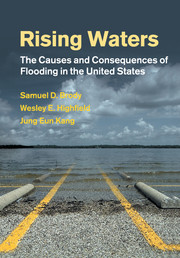Book contents
- Frontmatter
- Contents
- Preface
- Acknowledgments
- Abbreviations
- 1 Introduction: rising waters
- Part I The consequences of floods
- 2 Rising cost of floods in the United States
- 3 Impacts of flooding in coastal Texas and Florida
- 4 National and state flood policy mitigation in the United States
- Part II Planning decisions and flood attenuation
- Part III What are we learning?
- Part IV Policy implications and recommendations
- 12 Conclusions
- References
- Index
3 - Impacts of flooding in coastal Texas and Florida
from Part I - The consequences of floods
Published online by Cambridge University Press: 28 April 2011
- Frontmatter
- Contents
- Preface
- Acknowledgments
- Abbreviations
- 1 Introduction: rising waters
- Part I The consequences of floods
- 2 Rising cost of floods in the United States
- 3 Impacts of flooding in coastal Texas and Florida
- 4 National and state flood policy mitigation in the United States
- Part II Planning decisions and flood attenuation
- Part III What are we learning?
- Part IV Policy implications and recommendations
- 12 Conclusions
- References
- Index
Summary
A glance at national and statewide flooding trends as presented in the previous chapter reveals just how vulnerable Texas and Florida are, compared with other states in the U.S. Both states consistently rank in the upper echelon when it comes to financial and human losses associated with floods. In fact, Texas experiences so many human casualties from flooding, the figure presents itself as a statistical outlier in our datasets. Moreover, Texas ranked fourth in the U.S. in property damages (both overall and insured) and sixth in crop damages. Florida fared no better in our analysis. This state was thirteenth in overall property damages (third for insured losses at almost $2.5 billion) and fourth in crop damages from floods.
These figures should come as no surprise. Both Texas and Florida contain very large populations (second and fourth in the U.S., respectively) living in vulnerable coastal areas, with the population expected to increase in the near future. Rapid population growth and sprawling development in low-lying, flood-prone areas that receive large amounts of yearly rainfall is a basic recipe for creating flood disasters. These states have set themselves up in a development–disaster cycle. However, Texas and Florida are large and varied, and floods tend to be localized problems. To really understand the nature of exposure to risk and flooding in Texas and Florida, we need to magnify our spatial resolution and better understand the variations within the states themselves.
- Type
- Chapter
- Information
- Rising WatersThe Causes and Consequences of Flooding in the United States, pp. 31 - 55Publisher: Cambridge University PressPrint publication year: 2011



